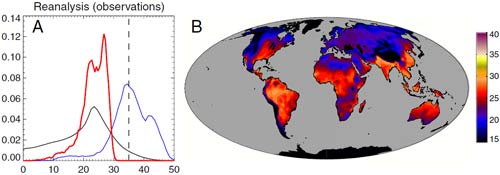
Figure 1: (A) Histograms of temperature (Black), Maximum Temperature (Blue), and Wet-bulb Temperature Tw (Red) during the last decade (1999–2008). (B) Map of Wet-bulb Temperature Tw.
It's widely agreed that warming over 6°C would have disastrous consequences for humankind. Increased drought and rising sea levels are the usual poster boys for climate impacts (and for good reason). However, the direct impact of heat stress on humans gives us a clear climate impact benchmark. Some argue that humans will simply adapt, as we already tolerate a wide range of climates today. But a new paper An adaptability limit to climate change due to heat stress (Sherwood 2010) shows this argument is false. Even modest global warming could expose large fractions of the population to unprecedented heat stress, and severe warming would lead to intolerable conditions over wide regions.
Human skin temperature is regulated at around 35°C. The human body needs to be warmer than it's environment in order to cool. Specifically, it needs to be warmer than the wet-bulb temperature Tw, measured by covering a standard thermometer bulb with a wetted cloth and fully ventilating it. Sherwood 2010 estimates that the survivability limit for peak six-hourly Tw is probably close to 35°C for humans - any longer results in hyperthermia.
Figure 1 depicts temperature over the last decade (1999 to 2008). The black line in Box A is a histogram of annual surface temperature. The blue line is annual maximum temperature. Of particular interest is the red line, showing a histogram of the wet-bulb temperature Tw. Note the vertical dashed line in Box A - this denotes the critical threshold of 35°C. The map also shows the wet-bulb temperature across the globe.

Figure 1: (A) Histograms of temperature (Black), Maximum Temperature (Blue), and Wet-bulb Temperature Tw (Red) during the last decade (1999–2008). (B) Map of Wet-bulb Temperature Tw.
While the distribution of temperature (black) is broad, wet-bulb temperature (red) has a much more narrow range. This means the peak heat stress is surprisingly similar across many regions on Earth. Even though the hottest temperatures occur in subtropical deserts, relative humidity there is so low that Tw is no higher than in the deep tropics. The result is that over the last decade, Tw has never exceeded 31°C.
The effect of global warming is an upward shift of the wet-bulb temperature distribution. Sherwood 2010 concludes that global warming of roughly 7°C would create small zones where metabolic heat dissipation would for the first time become impossible, calling into question their suitability for human habitation. A warming of 11 to 12°C would expand these zones to encompass most of today’s human population. If warmings of 10°C were to occur in next three centuries, the area of land likely rendered uninhabitable by heat stress would dwarf that affected by rising sea level.
Posted by John Cook on Tuesday, 11 May, 2010
 |
The Skeptical Science website by Skeptical Science is licensed under a Creative Commons Attribution 3.0 Unported License. |